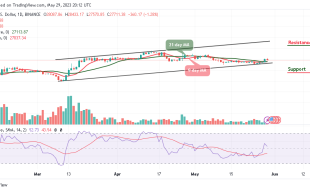Join Our Telegram channel to stay up to date on breaking news coverage
Ethereum underwent a groundbreaking transformation during its historic merge in September, transitioning into a proof-of-stake blockchain. This shift revolutionized the way transactions are confirmed, relying on validators to stake their Ether (ETH) tokens.
The Shanghai upgrade, implemented in March, further turned out to be a significant milestone as it finally allowed stakers to withdraw their locked Ether.
Over the years, the Ethereum ecosystem has witnessed the emergence of various investment themes, including decentralized finance (DeFi), stablecoins, wrapped versions of Bitcoin (BTC), and non-fungible tokens (NFTs). Moreover, the network’s expansion now includes fixed-income assets, offering additional avenues for users to generate income.
In traditional finance (TradFi), yield plays a pivotal role, as fluctuations in yield impact the perceived risk associated with other financial assets. This has led compliance professionals to closely monitor trends in the risk-free rate set by institutions like the United States Federal Reserve.
By analyzing these rates, they can detect suspicious fund movements that may be indicative of money laundering attempts. Money launderers seek to blur the origins of illicit funds rather than actively pursue financial gains like regular investors.
The Shanghai upgrade not only introduced new capabilities but also potentially enhanced the field of crypto forensics. Ethereum’s staking yield now serves as the “risk-free rate” within the crypto ecosystem. This development provides a valuable tool for analyzing and detecting suspicious financial activities within the crypto space.
Contrasting Approaches to Detecting Financial Crimes in Traditional Finance and Cryptocurrency
In the world of traditional finance (TradFi), automatic systems are utilized to mitigate the risk of financial crimes. These systems employ data-driven models designed by data scientists to identify and flag suspicious transactions. However, the approach to detecting potentially illicit usage of financial assets in the crypto industry differs significantly.
In the cryptocurrency industry, the focus of investigators is less on the specific activities and more on identifying the entities involved in criminal behavior. Cryptocurrency investigators primarily analyze networks of crypto wallets to trace the movement of illicit funds. Their aim is to identify transfers of criminal assets and unravel the complex web of money laundering.
Money laundering in the crypto space typically involves three stages: placement, layering, and integration. However, the detection and prevention efforts primarily target the placement stage. This initial stage is where the illicit funds enter the crypto ecosystem and are transferred or “placed” into various wallets or exchanges to obscure their origins.
Leveraging Ethereum Staking Rewards to Detect Illicit Financial Activities
In order to effectively develop strategies for identifying layering techniques, it’s important to think like criminals who hide their money trails. One reliable way to uncover such activities is by detecting unusual movements of assets, since money laundering isn’t usually about making profits.
In the crypto industry, Ether’s staking yields following the Shanghai Upgrade now serve as a reference point for determining risk-reward structures within the crypto space. Armed with this knowledge, investigators can systematically identify financial behaviors that deviate from the expected trends established by the benchmark interest rates.
For instance, investigators might observe a consistent pattern involving a specific address or group of addresses associated with an entity taking on unusually high risks while earning returns below the risk-free rate. Such behavior would undoubtedly trigger scrutiny if it occurred within a banking context.
An example of how this approach can be applied is in the detection of wash trading in non-fungible tokens (NFTs). Wash trading involves collusion among multiple market participants who engage in numerous NFT trades, primarily to layer illicit assets or manipulate prices. Since these transactions are not driven by profit-seeking motives, they are highly suspicious and warrant immediate attention.
Moreover, when proceeds from terrorist activities are layered through decentralized finance (DeFi) protocols, the identification of illogical asset movements can provide significant leads to investigators, even in the absence of detailed knowledge about the actual crime being perpetrated.
Leveraging a proactive transaction surveillance architecture, law enforcement agencies and financial institutions can effectively detect and prevent illicit activities associated with layering techniques. This approach is not just limited to the crypto landscape but also extends to other domains where asset movements can serve as vital clues in the pursuit of criminal investigations.
Traditional Capital Markets, DeFi Ecosystems, and Battle Against Financial Crimes
Traditional capital markets have historically served as a covert means of transferring funds to bypass sanctions and finance terrorist activities. Similarly, the emergence of decentralized finance (DeFi) ecosystems has provided an attractive opportunity for financial criminals to exploit the blockchain’s capabilities for the cross-border movement of significant assets.
Recent incidents, such as the high-profile collapse of FTX, have triggered a notable shift in trading activities from centralized exchanges to decentralized alternatives. This surge in DeFi volumes has inadvertently created an environment where illegal flows can easily evade detection, perpetuating the cloak of anonymity surrounding illicit transactions.
Moreover, centralized crypto service providers, driven by regulatory pressure, have started implementing stricter compliance controls. While these measures are intended to enhance transparency and deter criminal activities, they inadvertently force illicit actors to seek out alternative channels for money laundering and other financial crimes.
As a result, the range of crimes funneling illicit funds into DeFi ecosystems is expanding, necessitating the strengthening of forensic capabilities to investigate complex fund flows across diverse protocols, all without prior knowledge of the origin of criminal assets.
In light of this paradigm shift in the crypto markets, compliance efforts must pivot towards uncovering layering typologies. The rapid progress in blockchain interoperability underscores the critical importance of systematic surveillance to detect and prevent criminal transfers effectively.
However, the challenge of detecting suspicious activity in the cryptocurrency sphere persists. The extreme price volatility characteristic of digital assets poses a significant hurdle, rendering static risk
thresholds ineffective and providing a window of opportunity for money laundering to go undetected.
Addressing this issue requires innovative solutions, such as the establishment of benchmark rates. If Ethereum were to set such a benchmark, it could serve as a foundational reference point for assessing the rationality of fund flows, thereby facilitating the identification of anomalous transactions.
To effectively combat financial crimes within the crypto landscape, it is crucial to adapt compliance efforts, enhance forensic capabilities, and explore strategies that mitigate the impact of extreme price volatility. By doing so, authorities and stakeholders can work towards maintaining the integrity of the financial system while curbing illicit activities facilitated by traditional capital markets and emerging DeFi ecosystems.
Related Articles
- Best Cryptos to Buy
- How to Buy Ethereum
- Scammers Steal $15 Million in Crypto Through HitBTC Website Clone
- The victims of a crypto fraud targeting internet acquaintances lose billions
Best Wallet - Diversify Your Crypto Portfolio
- Easy to Use, Feature-Driven Crypto Wallet
- Get Early Access to Upcoming Token ICOs
- Multi-Chain, Multi-Wallet, Non-Custodial
- Now On App Store, Google Play
- Stake To Earn Native Token $BEST
- 250,000+ Monthly Active Users
Join Our Telegram channel to stay up to date on breaking news coverage



